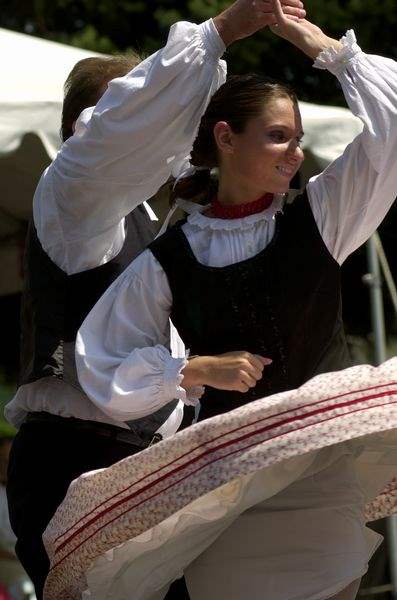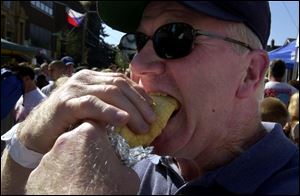
Hungarian fest focuses on food, fun, and dancing
8/19/2002
Paul Soltesz and Ann Rezbanyay, both of Oregon, perform a traditional dance at the Birmingham Ethnic Festivals.
The Blade
Buy This Image

Paul Soltesz and Ann Rezbanyay, both of Oregon, perform a traditional dance at the Birmingham Ethnic Festivals.
Decked out in her traditional Hungarian-styled bright knee-length skirt, white shirt, black vest, and tall black boots, Karen Majewski danced around in circles, holding hands with seven other female members of Cspike, a Hungarian dance group based in Toledo and Detroit.
“I've been doing this for 18 years, but I'm not Hungarian. Some of us are and some aren't,” said Ms. Majewski of Hamtramck, Mich., who has studied and performed various ethnic dances before focusing on the Hungarian-style dances seen yesterday at the 28th annual Birmingham Ethnic Festival in East Toledo.
The dancers walked, skipped, and ran in circles to the beat of their own voices, following one another as they snaked around the Calvin United Church of Christ parking lot at Bakewell and Consaul streets and performed the Karikazo, a wedding dance in which the steps are thought to symbolize a bride's reluctance.
“I've seen all different kinds of dancing, and for me, this is the most exciting, the most challenging, and the most vibrant,” Ms. Majewski said. “You have to be able to speak dozens of different dance dialects. Every region [of Hungary] - then, within every region, every village - has its own dance forms. You need to know the differences between one village and the village next door.”
Csipke, formed three years ago, was just one of many performing groups to grace the East Toledo neighborhood's “A Sunday in the Old Country” ethnic festival, which focuses on Hungarian dancing, food, and fun because of Birmingham's traditionally Hungarian population.
But with carnival food, games, and rides and local bands playing on various stages, the festival was geared toward everyone.
Like many of the festival goers, Ed and Karen Kowalski of Maumee aren't Hungarian, but it didn't matter. Their plan was simply to “walk around eating, drinking, and being merry. We enjoy it - the ethnic food, the dancing, the people.”

Butch Yates of Mobile, Ala., takes a big bite out of his Hungarian hot dog.
“The weather is nice, the people are nice, and the food is good,” Mrs. Kowalski said as she enjoyed the shade under a tent in the Calvin United Church parking lot.
Neither food nor people was in short supply yesterday. The festival brings in an average of 40,000 people every year, festival Chairwoman Barbara Lavender said, and food booths were lined up and down Consaul offering everything from Mexican and Chinese to cotton candy.
The Hungarian food included everything from potato pancakes, fried cabbage and noodles, kolbasz sausages, and “city chicken,” which, according to a sign outside the Papa Andy's Old World Foods trailer, is not really chicken, but seasoned pork that is breaded, deep fried, and baked.
“In the olden days, only the rich people in Europe could afford chickens, but the poor farmers all raised pigs,” the sign informed passersby. “The breaded pork on a stick looked like a drumstick to the children, so hence the name city chicken.”
Rhonda Verb of Curtice brought her six children to the festivities. Resting on the steps of St. Stephen's Church, she said they were all having a good time, though their activities varied.
Two of her daughters, Kayla, 12, and Tara, 14, showed off what they have been practicing all year as members of Magyar Dancers. The group performed twice.
Meanwhile, her sons enjoyed other aspects of the one-day celebration.
“They are having a blast,” she said.